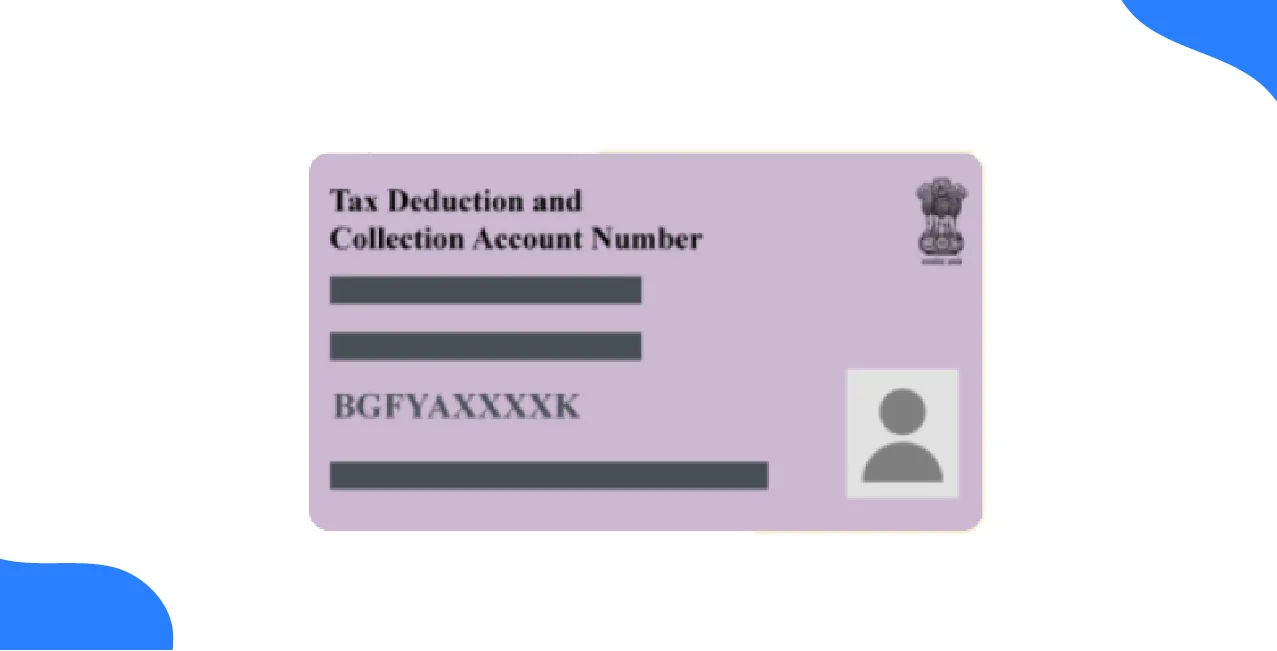
Author
LoansJagat Team
Read Time
6 Min
11 Aug 2025
TAN Number – Meaning, Format & Application Process in India
A TAN (Tax Deduction and Collection Account Number) is a 10-character alphanumeric code issued by the Income Tax Department. It is mandatory for anyone who deducts or collects tax at source under Indian tax laws.
For example, Mohit runs a digital marketing agency in Jaipur. When he pays ₹60,000 to a freelance designer, he must deduct TDS before making the payment. To deposit this TDS with the government and file returns, Mohit needs a valid TAN. Without quoting TAN, his TDS return will be rejected, and he may face a penalty.
To deposit this TDS with the government and file returns, Mohit needs a valid TAN. Without quoting TAN, his TDS return will be rejected, and he may face a penalty. In Mohit's case, quoting the TAN helps the government credit the tax properly to the freelancer’s account and keeps Mohit compliant with tax rules.
Read More – How to File TDS Return – Step-by-Step Process for Filing
Who Needs to Apply for a TAN?
Anyone who deducts or collects tax for the government must apply for a TAN. It is a rule under Indian tax law. If you are making payments where TDS (Tax Deducted at Source) or TCS (Tax Collected at Source) applies, you must get a TAN from the Income Tax Department.
You must use your TAN in:
- All TDS or TCS returns you file online
- Any challan (form) used to pay TDS or TCS
- All TDS or TCS certificates you give to others
For example, if Riya runs a business and pays rent or professional fees that require TDS, she must obtain a TAN. Without it, she cannot file her TDS returns or pay the deducted tax properly.
Getting a TAN helps the government track taxes easily and ensures that the right person gets credit for the tax paid.
Why a TAN Number Is Important?
A TAN is not just a number; it is a legal requirement for anyone deducting or collecting tax. Without it, a person cannot file TDS or TCS returns properly. If someone does not apply for a TAN or fails to mention it in the required documents, they can be fined ₹10,000.
Not having or quoting the TAN can cause:
- Trouble in filing TDS or TCS returns
- Delay in tax credit to the payee
- Legal penalty of ₹10,000
TAN must be quoted in these documents:
- TDS or TCS returns/statements
- Challans for making TDS or TCS payments
- TDS or TCS certificates are given to the deductees
- Various Income Tax-related forms submitted to the department
Using the TAN correctly helps avoid penalties and keeps all tax records clear and legal.
What is the Structure of a TAN?
A TAN (Tax Deduction and Collection Account Number) is a 10-character alphanumeric code. Each part of this code has a clear purpose and helps identify the person or business that is deducting or collecting tax.
Here is how the TAN is structured:
- First 3 letters – Show the jurisdiction (the region or city) where the TAN is issued.
- 4th letter – Is the first letter of the name of the person or organisation applying for the TAN.
- Next 5 characters – Are unique numbers automatically generated by the system.
- Last character – Is a random letter, also generated by the system.
This structure helps the Income Tax Department track and manage TDS and TCS filings more accurately.
How to Apply for a TAN?
You can apply for a TAN in two ways: Offline and online. Both methods are simple and do not require you to submit extra documents to the Income Tax Department.
Also Read - What is TDS? Full Form, Meaning, Deduction Limits & How to Claim a Refund
1. Offline TAN Application – Step by Step
- Fill out Form 49B, which you can get from any TIN-Facilitation Centre (TIN-FC) or download from the NSDL website.
- Submit the filled form at the nearest TIN-FC of Protean.
- Pay the required fee at the time of submission.
- No documents are needed for in-person applications.
- The TIN-FC will send your form to the Income Tax Department for verification.
2. Online TAN Application – Step by Step
- Visit the NSDL website and go to the TAN application page.
- Read the instructions and fill in Form 49B online.
- After submitting, you will receive an acknowledgement number.
- Print and sign the acknowledgement and post it to the NSDL office in Pune.
- Pay the fee online or through a cheque or a demand draft.
After checking your details, the Income Tax Department will issue your TAN. NSDL will then send the TAN either to your postal address or email, as mentioned in your form.
TAN Application Fee and How to Search TAN
Applying for a TAN is simple and affordable. The application fee is ₹65, which includes Goods and Service Tax(GST). This fee stays the same whether you apply online or offline.
How to Search for a TAN?
If you want to find the TAN of a person or business that collects or deducts tax, you can easily do this on the Income Tax e-filing portal.
Steps to search for a TAN:
- Go to the official e-filing portal.
- On the homepage, click “Know PAN Details” under Quick Links.
- Choose the deductor’s category (like company, firm, or individual).
- Enter the deductor’s name, state, and your mobile number.
- Click “Continue.”
- Enter the OTP sent to your mobile.
- A list will appear showing names that match your search.
- Click on the correct name to view the TAN, basic details, and AO (Assessing Officer) details.
This service helps ensure you use the correct TAN when filing or verifying TDS/TCS transactions.
Difference Between PAN and TAN
Both PAN (Permanent Account Number) and TAN (Tax Deduction and Collection Account Number) are 10-digit alphanumeric codes issued by the Income Tax Department. However, they serve different purposes and apply to different users. The table below explains the key differences
This table clearly indicates that while PAN is required for everyone who pays tax, TAN is only necessary for those who deduct or collect tax. Both are essential for staying compliant with Indian tax laws.
Note: The application fee may change from time to time. Please check the latest fee before applying.
Conclusion
A TAN helps the government track who collects and deducts tax at source. If you handle payments where TDS applies, you must get a TAN. It keeps tax records clear and avoids trouble later. In short, TAN makes tax deduction simple, legal, and well-recorded.
FAQ’s
1. Why do companies need a TAN in India?
Companies must use the Tax Deduction at Source (TDS) method to deduct tax at source and report it to the Income Tax Department. It ensures that tax is collected properly.
2. Can individuals get a TAN number?
Yes, individuals who deduct TDS while making payments (like rent or salary) must get a TAN.
3. Are PAN and TAN the same thing?
No, PAN tracks your tax records, while TAN is only for tax deduction and collection purposes.
4. What happens if I file TDS without a TAN?
The government will treat your filing as invalid, and you may face penalties for non-compliance.
5. How long does it take to get a TAN?
You usually receive your TAN within 7 to 15 days after applying online or offline.
Other Related Pages | |||
About the Author

LoansJagat Team
‘Simplify Finance for Everyone.’ This is the common goal of our team, as we try to explain any topic with relatable examples. From personal to business finance, managing EMIs to becoming debt-free, we do extensive research on each and every parameter, so you don’t have to. Scroll up and have a look at what 15+ years of experience in the BFSI sector looks like.

Quick Apply Loan
Subscribe Now


